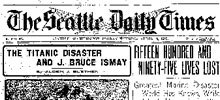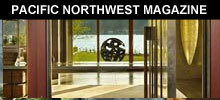Originally published March 31, 2010 at 7:00 PM | Page modified June 23, 2013 at 1:09 PM
D.I.Y. downtown: A self-guided tour through Seattle history
A National Park Service Web site provides a do-it-yourself guide to touring Seattle's historical high points.
Special to The Seattle Times
KEN LAMBERT / THE SEATTLE TIMES
The history of the Northern Lights Dome Room ceiling in the Arctic Club building on Third Avenue stretches back to its years as a social club for the elite of the gold-rush years. Today, the building is a hotel.
KEN LAMBERT / THE SEATTLE TIMES
Faux gold bars at the Klondike Gold Rush National Historical Park represent the gold rush, a key moment in the city's evolution.
KEN LAMBERT / THE SEATTLE TIMES
The Paramount Theatre, host of films and live performances since opening in 1928, went through extensive restoration work in the 1990s.
KEN LAMBERT / THE SEATTLE TIMES
Oliver's Lounge at the Mayflower Park Hotel offers a place to lunch and set the mood for exploring historic buildings in Seattle. The building, constructed in 1927, is considered the oldest continuously operating hotel in downtown Seattle.
If You Go
Self-guided Seattle history tour
My trip planner and source for historical information was the National Park Service's Web site, "Seattle: A National Register of Historic Places Travel Itinerary," found at www.nps.gov/history/nr/travel/seattle, and informational signs posted on displays and buildings.
Also: Historic Hotels of America, a program of the National Trust for Historic Preservation: www.historichotels.org.
Tip
Sidewalks are accessible in downtown Seattle, but the downtown area is hilly. East/west streets are often steep inclines. The north/south avenues aren't steep. Those not up to the walk should take advantage of Metro's downtown free-ride zone. See www.metro.kingcounty.gov.
Other guides and tours
Destination Heritage has produced maritime, industry and agriculture guides for King County locations. See www.destinationheritage.org.
Historylink, at www.Historylink.org, is a free online source for Washington state history.
Seattle Architecture Foundation offers a variety of Seattle-area architectural tours and sells a self-guided tour book. 206-667-9184 or www.seattlearchitecture.org/tours.html.
Along the way
Also historical, and worth seeing:• Pioneer Square transit station: The gigantic 11-foot- diameter cast-iron wheel on display only yards from where it was found was a terminal sheave for the Yesler Way Cable Car Line, which operated from 1888 to 1940.
• The Visitor Information booth on the south side of the brick-surfaced Occidental Park (between the Klondike Gold Rush National Historical Park and the pergola) was constructed from portions of an elevator cab that once operated in the Maynard Building.
• Smith Tower (506 Second Ave., www.smithtower.com, 206-622-4004), at 522 feet, was the fourth-tallest building in the world when it opened in 1914. Uniformed operators run the ornate brass and copper 1914 Otis elevators — some of the last manually operated elevators on the West Coast. The 35th floor Chinese Room (named for the décor) and the open-air observation deck are open for self-guided tours daily from April to September. Tickets: adults, $7.50; seniors and students $6; children 6-12, $5; free for ages 5 and younger.
• St. Charles Apartments, 619 Third Ave. (next to the Lyon Building), housed the Rector Hotel in 1913, which "provided accommodation for the patrons of the Grand Seattle Opera."
• The 22-story art deco-style Exchange Building, 821 Second Ave., is open to the public during business hours Monday-Friday. In its stunning lobby — gold-leaf ceiling and gold-veined black marble walls — a display traces the building's development against a backdrop of local and international events. Opened in May 1930, it was to house more stock and mercantile exchanges than any building in the U.S. The 1929 Stock Market crash subdued those plans.
![]()
As I stood under Pioneer Square's pergola, my notes had taken me more than 100 years back in time, so I was startled when a man sitting on a nearby bench called out, "Are you on a scavenger hunt? You seem to be looking for something."
He'd nailed it. Much like those Klondike gold seekers who helped put Seattle on the map, I was on a hunt for history, thanks to modern-day technology. While Web surfing I'd discovered a National Park Service site called "Seattle: A National Register of Historic Places Travel Itinerary," which highlights some 37 residential, commercial, industrial and religious locations stretching from the Columbia City Historical District in the south to the Ballard Avenue Historical District in the north.
Using the Web site and links from it (such as "Historic Hotels of America"), I outfitted myself for the search: a guidebook of sorts — pages I'd printed out — including the Park Service's travel itinerary, its map and fact sheets; and information on two historic hotels.
I couldn't cover all Seattle's historic sites at once, but my downtown day trip would take me from Seattle's infancy through Prohibition, the Great Depression and the early 20th Century. I began as the city had, in Pioneer Square.
10 a.m.
Klondike Gold Rush National Historical Park: This seemed like a good place for getting grounded in Seattle history. The museumlike visitor center is housed in a restored, multistory red-brick building, once the Cadillac Hotel, at 319 Second Ave. S.
Exhibits explain the impact on Seattle of the 1897 gold-seeking "stampeders," who outfitted here for the trip north, and the life they lived in the northern goldfields. With sales of supplies reaching $25 million by early 1898, this early-day commercial area that we now call Pioneer Square was booming.
Five blocks northwest, on Yesler Way (once called "Skid Road" because lumber was skidded down its slope to the mill), I visited the Iron Pergola (its official historic name), on the site of the city's first mill (built in 1853 by Henry Yesler).
The pergola was built in 1909, reputedly the most elaborate west of the Mississippi. It sheltered riders waiting for cable cars, and sat atop some fancy underground public restrooms. A neighboring totem pole appeared in 1899, reportedly after it was stolen from Tlingit Indians by Seattle Chamber of Commerce members while they vacationed in Alaska.
Completed in 1892, the towering brick and terra cotta Pioneer Building, 600 First Ave., east of the pergola, housed 48 different mining-firm offices during the Gold Rush. During Prohibition, it was home to Seattle's finest speak-easy. Cage elevators still operate in the building's lobby.
Today Bill Speidel's Underground Tour (www.undergroundtour.com, 206-682-4646) begins next to Doc Maynard's Public House, a restored 1890s saloon in the Pioneer Building.
11 a.m.
Northbound from Pioneer Square transit station: The six-story Lyon Building, 607 Third Ave., helped move the city toward the concept of skyscrapers back in 1910. (Look up to see the terra cotta frieze and classical cornice at the top.)
Across the street and to the north, carved walrus heads are showcased on the exterior of the Arctic Club, 700 Third Ave., once the home of an exclusive social club spawned by the Klondike gold-rush wealth. Its members' enjoyed — among other benefits — a ladies' tea room, billiard and card rooms, and grand functions in its spectacular Northen Lights Dome Room.
The club is now a Doubletree Hotel. A yesteryear ambience emanates from the lobby's fireplace and leather couches, walls filled with some 200 black-and-white portraits of long-ago members, and a hatcheck rack (with hats) behind the registration desk.
A block west, the 18-story, 1911 Beaux Arts-design Hoge Building, 705 Second Ave., is considered the city's second true "skyscraper." (Check out the elaborately sculpted ceilings in its Bank of America branch.)
Six blocks north to University Street and one block east, I was in another art deco lobby, of what was the Northern Life Tower, at 1212 Third Ave. Now dwarfed by other buildings, at 27-stories it was a true skyscraper in 1928, and made a dramatic change in the city's skyline. Its elegant black marble lobby is open to the public during weekday business hours.
Across the street, the Cobb Building, 1301 Fourth Ave., home to the Capital Grille Restaurant, was built as part of a 1907 urban development plan to create a commercial center in Seattle. (Look up to see its terra cotta trim).
Noon
Mayflower Park Hotel, 405 Olive Way: I lunched in the hotel's Oliver's Lounge, just off Westlake Center. The hotel, built in 1927, was called the Bergonian and, according to Historic Hotels of America, is the oldest continuously operating hotel in downtown Seattle.
1:30 p.m.
Westbound to Pike Place Market: Walking four blocks west on Pine Street from Westlake Center, I was off to explore the Pike Place Market Historic District. In 1907 the City Council approved the market's creation along a then-new four-block boardwalk called Pike Place. Frank Goodwin, a local landowner, built the first marketplace building in 1908. The warren of gift and specialty shops operating these days below street level is in the area known as "Down Under." These were once open air stands built by Goodwin in 1911 to meet the farmer's demands for increased selling space. Over the years they have been gradually converted into enclosed spaces.
The neon sign outside the Athenian Seafood Restaurant and Bar (www.athenianinn.com), on the Market's main floor, is as old as the place itself. The restaurant has been around since 1909, when three Greek brothers opened it as a bakery and luncheonette.
2:30 p.m.
Eastbound to the theater district: Walking from the market, my next stop was the former Coliseum Theater, at Pike Street and Fifth Avenue. Now home to retailer Banana Republic, its still-grand exterior explains why it was once called a "movie palace." When it opened in 1915 it was the first Seattle theater built to show movies and continued to do so through the 1970s.
Three blocks east and one south, the 1924 Eagles Auditorium, 1416 Seventh Ave., a Renaissance-revival style building with must-see terra cotta, is now called Kreielsheimer Place and houses ACT Theater.
Nearby, the Paramount Theatre, 911 Pine St., which opened in 1928, was also considered a "movie palace." Volunteers lead tours of its interior on the first Saturday of each month (206-682-1414, www.stgpresents.org).
Tour's end
I'd spent less than six hours time-traveling through a century when my feet and pedometer (reading just over four miles) said it was time to stop.
I hadn't made it to half the places on my list and there are so many more places to visit: the Chinatown International District and King Street Station ... Lake Union ... the Old Georgetown City Hall ... the Harvard-Belmont Historic District and Volunteer Park ...
Plenty of material for more interesting time travel.
Jackie Smith is a freelancer writer who lives in Kirkland.


















